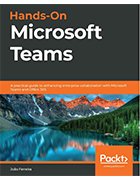Microsoft Teams meetings tutorial offers best practices
In this Microsoft Teams meetings tutorial, learn the features and functionalities of virtual meetings and live events, from customizing meeting requests to sharing content.
Organizations are relying on online meeting services now more than ever to support employee communication and collaboration. Microsoft Teams offers a plethora of capabilities to support remote and distributed workforces.
To ensure Teams meeting productivity and efficiency, end users must have a clear understanding of the platform's features, according to author João Ferreira in his new Microsoft Teams book.
The book, Hands-On Microsoft Teams, is available now from Packt Publishing and offers a complete guide to the Teams platform and its integrations, from techniques to build Teams into business workflows to best practices that enhance employee collaboration and productivity.
Below is an excerpt from the book titled "Meetings and Live Events in Microsoft Teams." This chapter provides a Microsoft Teams meetings tutorial that includes tips for scheduled and ad hoc team meetings, webinars and broadcasted live events.
Teams meetings can have up to 250 participants, and Teams offers users a variety of features and capabilities to enhance meeting productivity, including content sharing, whiteboarding and recordings. Teams integrates with third-party apps, as well as other Microsoft apps and services, including OneDrive and SharePoint, to enable users to meet, work and communicate within the context of their team or channel.
But a Teams meeting may not be the right option for all meeting scenarios. Employees must use live events for meetings that call for more than 250 participants. The live events support up to 10,000 participants, which suits several broadcast scenarios, such as town halls and webinars.
Explore Hands-On Microsoft Teams
Read the entire chapter, "Meetings and Live Events in Microsoft Teams."
Users can choose from three live event options that offer varying degrees of accessibility. Live events for specific people and groups will be available only to those invited to the event. Organization-wide events will enable everyone within the business to watch but require attendees to sign in. Public live events enable anyone to watch and do not require signing in. The live events capability also offers additional features, such as Q&A sessions and reports on attendee engagement and behavior.
Once readers learn the fundamentals of Microsoft Teams, they can expand their knowledge with this Microsoft Teams meetings tutorial to learn how to run meetings and events effectively and enhance collaboration.







